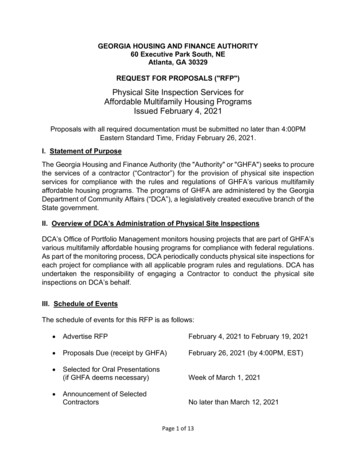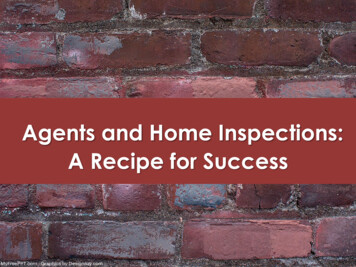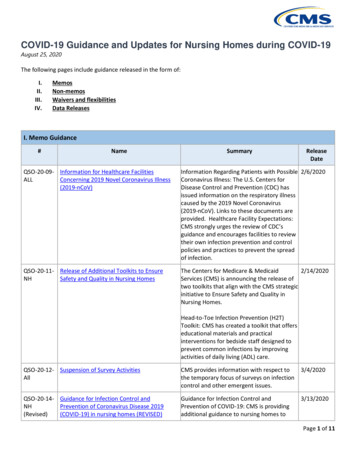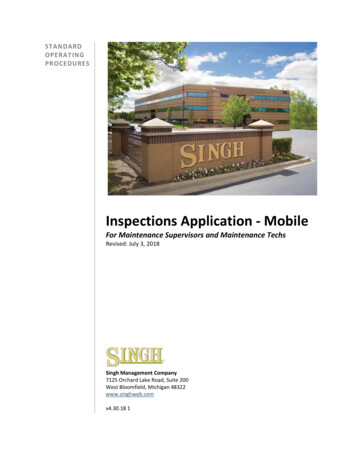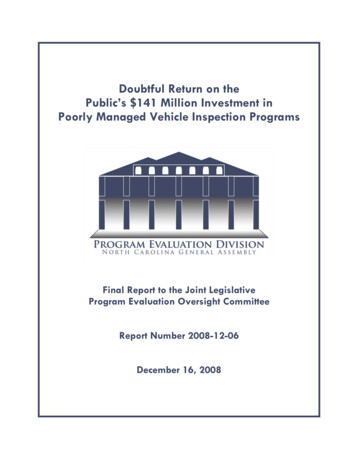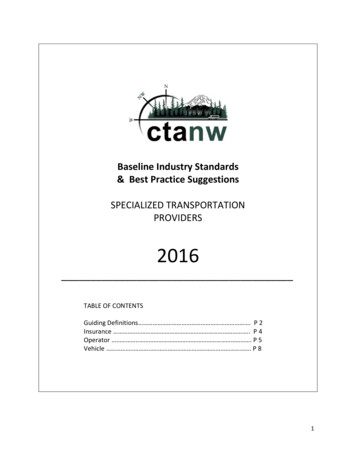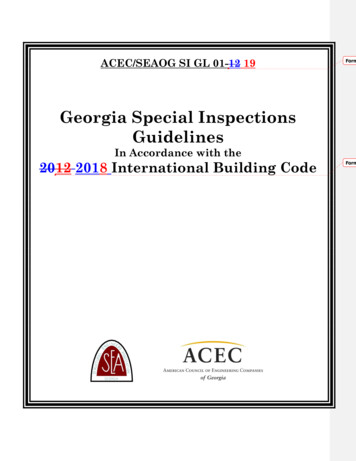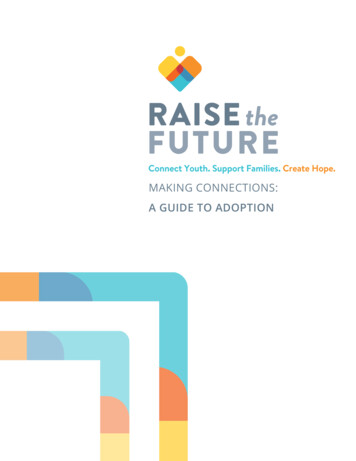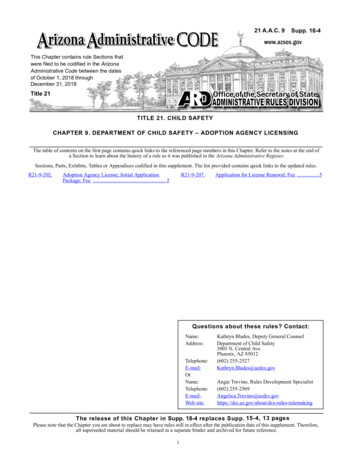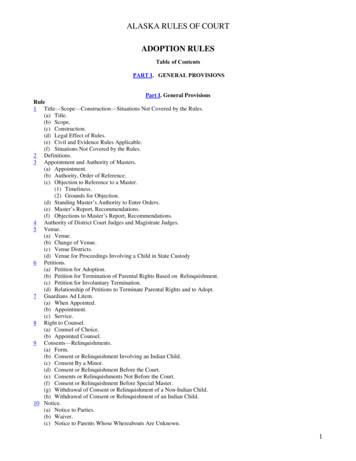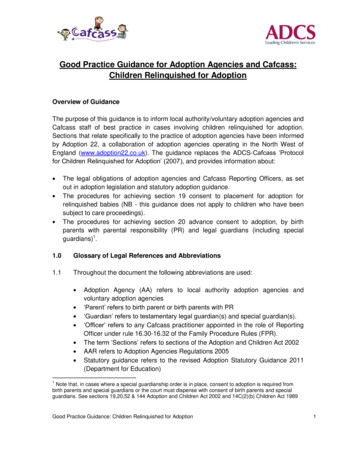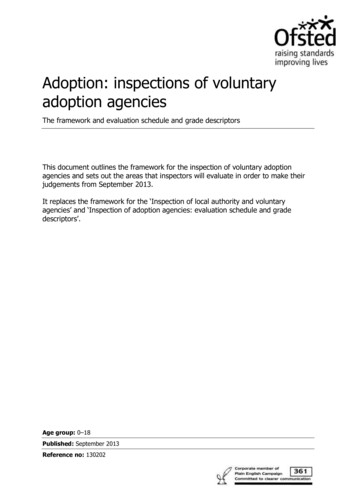
Transcription
Adoption: inspections of voluntaryadoption agenciesThe framework and evaluation schedule and grade descriptorsThis document outlines the framework for the inspection of voluntary adoptionagencies and sets out the areas that inspectors will evaluate in order to make theirjudgements from September 2013.It replaces the framework for the ‘Inspection of local authority and voluntaryagencies’ and ‘Inspection of adoption agencies: evaluation schedule and gradedescriptors’.Age group: 0–18Published: September 2013Reference no: 130202
The Office for Standards in Education, Children's Services and Skills (Ofsted) regulates and inspects toachieve excellence in the care of children and young people, and in education and skills for learners ofall ages. It regulates and inspects childcare and children's social care, and inspects the Children andFamily Court Advisory and Support Service (Cafcass), schools, colleges, initial teacher training, workbased learning and skills training, adult and community learning, and education and training in prisonsand other secure establishments. It assesses council children’s services, and inspects services forlooked after children, safeguarding and child protection.If you would like a copy of this document in a different format, such as large print or Braille, pleasetelephone 0300 123 1231, or email enquiries@ofsted.gov.uk.You may reuse this information (not including logos) free of charge in any format or medium, underthe terms of the Open Government Licence. To view this licence, nt-licence/, write to the Information Policy Team,The National Archives, Kew, London TW9 4DU, or email: psi@nationalarchives.gsi.gov.uk.This publication is available at www.ofsted.gov.uk/resources/130202.Interested in our work? You can subscribe to our website for news, information and updates atwww.ofsted.gov.uk/user.Piccadilly GateStore StreetManchesterM1 2WDT: 0300 123 1231Textphone: 0161 618 8524E: enquiries@ofsted.gov.ukW: www.ofsted.gov.ukNo. 130202 Crown copyright 2013
ContentsContents3Introduction5Legal basis for inspection5Frequency of inspection6Notice given for inspection6Inspectors7How the regulations and national minimum standards inform inspectionjudgements7The role of voluntary adoption agencies8Inspection activity8Grading inspection findings9Using the grade descriptors10Part one: voluntary adoption agencies offering a full range of adoptionservicesOverall effectivenessThe approach following an overall judgement of inadequateThe experiences and progress of and outcomes for children and young peopleQuality of service provisionSafeguarding children and young peopleLeadership and managementFitness and conditions of registration1212131416182123Part two: voluntary adoption agency branches that only offer adoptionsupportOverall effectivenessThe approach following an overall judgement of inadequateThe experience and progress of, and outcomes for, service usersQuality of service provisionSafeguarding children, young people, adults and familiesLeadership and managementFitness and conditions of registration2424252627283032Annex A: Part one.33Headline outcome statements from the national minimum standards forvoluntary adoption agencies that offer the full range of adoption services33Annex A: Part two.36Headline outcome statements from the national minimum standards forvoluntary adoption agency branches that only provide adoption support 36Outcomes36Adoption: Inspections of adoption agencies: evaluation schedule and grade descriptorsSeptember 2013, No. 1302023
Quality of service provisionSafeguardingLeadership and management373738Annex B: National minimum standards, regulations and adoption guidancerelevant to the evaluation schedule439Adoption: Inspections of adoption agencies: evaluation schedule and grade descriptorsSeptember 2013, No. 130202
Introduction1.This document sets out the judgements that inspectors make and report onwhen inspecting voluntary adoption agencies. It shows how the principles andprocesses underlying all Ofsted inspections are applied, sets out the statutorybasis for inspection, and summarises the main features of the inspectionprocess. There are two sections of grade descriptors, Part one and Part two.Part one applies to voluntary adoption agencies that offer the full range ofadoption services. Part two applies to voluntary adoption agency branches thatonly offer adoption support services.2.Throughout this evaluation schedule, references to children and young people,adoption and adopters include, where appropriate, children and young peoplewho may be adopted or who have been adopted; inter-country arrangements;people who enquire about and apply to adopt; prospective adopters; and thosewho have adopted.3.This framework and guidance remain subject to periodic review. Any changeswill be published on our website.Legal basis for inspection4.Ofsted inspects voluntary adoption agencies under the Care Standards Act2000.1 The Care Standards Act 2000 sets out Ofsted’s power to register andinspect voluntary adoption agencies and, where necessary, to enforcecompliance with statutory requirements including relevant regulations. Section9 of the Adoption and Children Act 2002 allows regulations to be made inrelation to the functions exercised by voluntary adoption agencies relating toadoption. The Care Standards Act 2000 at section 4(7) sets out a definition ofan adoption agency that refers to the definition of a voluntary adoption societyfound in section 2 of the Adoption and Children Act 2002.5.Ofsted is required to encourage the services it inspects and regulates to:1 improve be user-focused be efficient and effective in the use of resources.The Care Standards Act 2000; ts.Adoption: Inspections of adoption agencies: evaluation schedule and grade descriptorsSeptember 2013, No. 1302025
6.When inspecting voluntary adoption agencies, Ofsted gives consideration toknowledge and understanding gained from previous inspections and: the Care Standards Act 2000 the Adoption and Children Act 2002 the relevant regulations2 Adoption: National Minimum Standards. Department for Education. 2011 Adoption Guidance Adoption and Children Act 2002 Second revision July2013 (referred to as statutory guidance). Department for Education. 2013.Frequency of inspection7.The frequency of inspections is set out in regulations.3 Voluntary adoptionagencies must have at least one inspection during each three-year inspectioncycle.8.The timing of any inspection is influenced by an assessment of:9. any current complaints or enforcement action notifications received from the voluntary adoption agency the outcomes of previous inspections other relevant information held by Ofsted.Where we judge a voluntary adoption agency as inadequate, we normally reinspect it within 12–18 months.Notice given for inspection10. Ten working days’ notice will be given before an inspection begins.2Including: The Adoption Agencies Regulations 2005The Adoption Agencies (Miscellaneous Amendments) Regulations 2013The Adoption Support Agencies (England) and Adoption Agencies (Miscellaneous Amendments)Regulations 2005The Adoption Agencies and Independent Review of Determinations (Amendment) Regulations 2011The Adoption Information and Intermediary Services (Pre-Commencement Adoptions) Regulations2005The Adoption Support Services (Local Authorities) (England) Regulations 2003The Arrangements for Placement of Children by Voluntary Organisations and Others (England)Regulations 2011The Disclosure of Adoption Information (Post-Commencement Adoptions) Regulations 20053Her Majesty’s Chief Inspector of Education, Children’s Services and Skills (Fees and Frequency ofInspections) (Children’s Homes etc.) (Amendment) Regulations SI 2007/694, as amended6Adoption: Inspections of adoption agencies: evaluation schedule and grade descriptorsSeptember 2013, No. 130202
Inspectors11. Voluntary adoption agencies are inspected by trained social care inspectors.Usually there will be one inspector for each inspection.How the regulations and national minimum standardsinform inspection judgements12. Inspection is intended to help raise standards and support improvement in thesector. This requires a focus on the experiences and progress of children andyoung people. Inspectors evaluate how the agency contributes to deliveringimproved outcomes. The framework and the inspection judgements areunderpinned by the regulations, the national minimum standards and statutoryguidance. Ofsted wants all provision to achieve a good standard, not just theminimum standard, and our inspectors judge whether services are good or not,as well as whether they comply with basic requirements.13. The headline outcome statements for each standard can be found in Annex A,Part one and Part two, and the national minimum standards in full are on theDepartment for Education’s website.414. The introduction to the national minimum standards for adoption states that:‘Each standard is preceded by a statement of the outcome to be achieved bythe agency Agencies will normally show they are meeting the headlinestatement of the outcome by following the standards below. However, these donot have to be followed exactly if the agency can demonstrate, and Ofsted issatisfied, that the outcomes are being met in a different way. The exception iswhere standards refer to a requirement set out in regulations, in which case theregulation must be met.’15. The strengths and weaknesses of the agency will be highlighted throughout thereport to illustrate how inspectors have arrived at their judgement. Voluntaryadoption agencies are required to meet regulations and notices will be servedfor them to meet these when necessary. Any areas for improvement will be thesubject of a recommendation to help ensure that standards are met in amanner that helps ensure ‘good’ experiences, progress and outcomes forchildren and young people. Failure to meet regulations or observe standardswill be taken into account, as well as the impact of this on children and youngpeople.4Adoption: national minimum standards, DfE, blicationDetail/Page1/DFE-00028-2011.Adoption: Inspections of adoption agencies: evaluation schedule and grade descriptorsSeptember 2013, No. 1302027
The role of voluntary adoption agencies16. Voluntary adoption agencies recruit adopters for children who need families,regardless of which local authority is responsible for the child. Children fromany local authority in the UK can be placed with adopters approved by avoluntary adoption agency. Voluntary adoption agencies may also beresponsible for, and place, children themselves. The agency must contribute tomeeting the needs of children and young people through their recruitment,assessment, preparation and training of adopters, and through effectivesupport of adoptive families following a child’s placement. Certain branches ofvoluntary adoption agencies only provide adoption support. Part two of thisschedule applies to these branches.17. Through the inspection framework, Ofsted aims to raise standards and supportimprovement. This requires each voluntary adoption agency to have a veryclear focus on improving outcomes for children, young people, adults andfamilies. The inspection evaluates how effectively a voluntary adoption agencyworks in partnership with local authorities and contributes to ensuring thatchildren are placed appropriately and without avoidable delay.18. The inspection framework recognises adoption as an evolving and lifelongprocess for all those involved. It considers the impact of the agency’s work onthe lives of adopted adults, birth relatives and adoptive families, as well as onchildren and young people.Inspection activity19. Inspectors:8 evaluate and explore the agency’s work in relation to a sample of adoptersin order to judge the quality of practice and management and thedifference it makes to the lives of children and young people – thisincludes discussions with the agency provider, manager, staff, panelmembers, children’s social workers and other professionals working withchildren or young people who are living with adopters approved by thevoluntary adoption agency talk with, as appropriate, children, young people, adopters and adultadoption support users analyse information about the voluntary adoption agency to inform theinspection and inspection judgements, including the annual quality anddata form and returned questionnaires from all those involved with theagency.Adoption: Inspections of adoption agencies: evaluation schedule and grade descriptorsSeptember 2013, No. 130202
20. Full details of the method of inspection are available in Adoption: Conductinginspections of voluntary adoption agencies.5Grading inspection findings21. Inspectors make judgements against the evaluation schedule using a four-pointjudgement scale.OutstandingAn agency that is demonstrating the characteristics of agood judgement, where children and young people aremaking significantly better progress and achieving morethan was expected in all areas of their lives.GoodAn agency where children and young people, includingthose with the most complex needs, have their individualneeds met and their welfare safeguarded and promoted.They make good progress and receive effective services sothey achieve as well as they can in all areas of their lives.Requires improvementAn agency that may be compliant with regulations andobserving the national minimum standards (NMS) but is notyet demonstrating the characteristics of a good judgement.It therefore ‘requires improvement’ to be good. There maybe failures to meet all regulations or NMS but these are notwidespread or serious; all children’s and young people’swelfare is safeguarded and promoted.InadequateAn agency where there are widespread or serious failuresthat result in children and young people not having theirwelfare safeguarded and promoted.22. Voluntary adoption agencies must meet their responsibilities as set out in theequality legislation. For all children, young people, adopters and adult adoptionsupport users, the expectation is that the services provided are sensitive andresponsive to age, disability, ethnicity, faith or belief, gender, gender identity,language, race and sexual orientation.5Adoption: Conducting inspections of voluntary adoption agencies (130206), Ofsted, 2013;www.ofsted.gov.uk/resources/130206Adoption: Inspections of adoption agencies: evaluation schedule and grade descriptorsSeptember 2013, No. 1302029
Using the grade descriptors23. Part one of the evaluation schedule applies to voluntary adoption agenciesoffering a full range of adoption services. The judgements made are: overall effectiveness the experiences and progress of, and outcomes for, children and youngpeople quality of service (this includes the experience and progress of adultadoption support users) safeguarding children and young people leadership and management.24. Part two of the evaluation schedule applies to voluntary adoption agencybranches that only offer adoption support services. The judgements made are: overall effectiveness the experiences and progress of, and outcomes for, service users quality of service safeguarding of children, young people, adults and families leadership and management.25. The framework sets out the characteristics of a good voluntary adoption agencyfor all judgement areas. Inspectors use these criteria to evaluate theexperiences of children, young people, adult adoption support users andadopters, and the quality of services they receive. Inspectors make ajudgement of good where the characteristics set out are widespread across theagency and are leading to positive progress and experiences and improvedoutcomes for children and young people. Inspectors use professionaljudgement to determine the weight and significance of their findings forchildren and young people. A judgement of good is made where the inspectorconcludes that the evidence overall sits most appropriately with a finding ofgood.26. Voluntary adoption agencies must meet the requirements of statute andregulations, and take account of the national minimum standards and statutoryguidance.27. Meeting all the requirements does not of itself result in a judgement of good oroutstanding, nor does failure to meet all the requirements in full necessarilyresult in a judgement of requires improvement or inadequate. The quality ofthe service, the way in which standards are met, the seriousness of any failureand its potential impact on outcomes for children and young people areconsidered carefully to determine the overall judgement. Inspectors use theirprofessional judgement to assess the impact of any breach of regulation, or10Adoption: Inspections of adoption agencies: evaluation schedule and grade descriptorsSeptember 2013, No. 130202
failure to meet the national minimum standards or statutory guidance, againstother aspects of the services provided. However, it is expected that, in anagency judged to be outstanding, there are no breaches of regulations and, inan agency judged to be good, if there are any breaches of the detail of theregulations, these are infrequent, minor, have no impact on safeguarding orpromoting children’s welfare and can be immediately remedied (although theywill still be referred to in the inspection report).Adoption: Inspections of adoption agencies: evaluation schedule and grade descriptorsSeptember 2013, No. 13020211
Part one: voluntary adoption agencies offering a fullrange of adoption services28. This section applies to all voluntary adoption agencies and their branchesexcept those branches that offer only adoption support. Part two providesguidance on evaluating branches that only offer adoption support.Overall effectiveness29. Inspectors consider the evidence and judgements from across the evaluationschedule before arriving at the overall effectiveness judgement. They takeaccount of the context of the agency and whether they specialise in placementsfor particular groups of children, for example disabled children, or if theyspecialise in types of placements, for example ‘concurrent planning’.30. In an outstanding voluntary adoption agency: Direct work, provided by the agency, with children, young people andadoptive families is of the highest quality and is delivering measurablyimproved progress and/or outcomes. Some children and young people dofar better than was expected by people who are closely involved withthem. Inspirational, confident, ambitious and influential leadership of the agencychanges the lives of children and young people placed for adoption.Leaders are visible and effective. They innovate and attract creative ideasto sustain the highest-quality services for children and young people andtheir adopters. Effective and continuous learning improves professional practicethroughout the agency. This is sustained over time. Leaders, managersand staff have ambition and inspire high quality work with adopters, whichsupports exceptional progress and protects and promotes the welfare ofall children and young people who are adopted or placed through with theagency. There are no breaches of regulations.31. In a good voluntary adoption agency: 12Children and young people who have the most complex needs arecarefully and appropriately placed with adoptive families. The placementsare successful and are sustained through the provision of proactive andeffective support and interventions from, as appropriate, social workers;therapists; and health and education professionals. Where there aredelays in the delivery of services, the voluntary adoption agency canprovide clear evidence of their efforts to pursue services for the benefit ofthe child or young person.Adoption: Inspections of adoption agencies: evaluation schedule and grade descriptorsSeptember 2013, No. 130202
Recruitment processes are accurate, focused and analytical assessmentsof adopters produced in a timely manner. Partnerships between theadoption agency and other agencies ensure that individual children’sneeds are met without delay and that they are protected. The agency supports adoptive families so children’s and young people’swelfare is safeguarded and promoted. The children and young peoplebenefit from a stable family life and develop safe and secure relationshipswith adults which persist over time. Leaders and managers develop or maintain partnerships with localauthorities, are committed to adoption, have an accurate understanding ofthe strengths and weaknesses of the agency and take effective steps toimprove it. The views and experiences of children, young people, adopters and,where appropriate, adults receiving adoption support and birth relativesinfluence agency developments and strategic thinking. Any breaches of regulations are infrequent, minor and immediatelyremedied.32. In a voluntary adoption agency that requires improvement: The agency is not yet delivering good services to children and youngpeople, good support and preparation to adopters or good support to birthrelatives or adopted adults. It therefore requires improvement to get togood. However, there are no widespread or serious failures which result inindividual children, young people and, where appropriate, those receivingadoption support not having their welfare safeguarded and promoted, orin the significant loss of adoptive applicants.33. In a voluntary adoption agency that is inadequate: There are widespread or serious failures that result in children and youngpeople who are placed for adoption and, where appropriate, thosereceiving adoption support not having their welfare safeguarded andpromoted. This will be the case if any of the judgements are inadequate.The approach following an overall judgement of inadequate34. An overall effectiveness judgement of inadequate is made where there arewidespread and serious failures to comply with requirements, which result inchildren and young people, adoptive families, adults receiving adoption supportor birth relatives not having their welfare safeguarded and promoted. Seriousfailures may affect only one individual but will still lead to a judgement ofinadequate. In these circumstances, the inspector sets requirements to achievecompliance with the Care Standards Act 2000 and the relevant adoptionregulations. Inspectors may also make recommendations to help the registeredperson(s) to improve the quality and standards of care.Adoption: Inspections of adoption agencies: evaluation schedule and grade descriptorsSeptember 2013, No. 13020213
35. On making a judgement of inadequate, the inspector must consult with theSocial Care Compliance team, and must instigate a case review.36. The inspector should also consider consulting with the Social Care Complianceteam where there is any history of: complaints against the voluntary adoption agency that have not beendealt with in a satisfactory way failures to comply with regulations and/or national minimum standardsthat have not been dealt with in a satisfactory way failures to take satisfactory action to meet requirements/actions andrecommendations that call into question the suitability of the registeredperson.37. The purpose of the case review is to consider whether any enforcement actionshould be taken.38. When agencies are judged to be inadequate for overall effectiveness, the nextinspection will normally take place within 12-18 months. It will take placesooner if any further significant concerns arise during this period or if earlierinspection is necessary to meet statutory requirements.The experiences and progress of and outcomes for children andyoung people39. The most important outcome for children and young people who are to beadopted is that they should be placed into a stable adoptive family as early aspossible. In those adoptive families, they should: develop or achieve their potential develop or maintain a positive self-view begin to make positive attachments develop a knowledge and understanding of their background.Children should also understand and, if appropriate, influence what ishappening to them. The progress of children is judged in the context of theirindividual needs, experiences and starting points and recognises the potentialimpact of early trauma on their development. This may relate to a child oryoung person’s adoptive placement before or after an order has been madeand include the impact of adoption support on improving outcomes.40. The judgement evaluates the experiences and progress of, and outcomes for,children and young people, not who contributes to those outcomes. It isessential that agencies monitor children’s starting points and their progress inorder to understand the impact of their agency on children and young people.The agency’s input will be judged and reported on in other sections of thereport.14Adoption: Inspections of adoption agencies: evaluation schedule and grade descriptorsSeptember 2013, No. 130202
Good41. The experiences and progress of, and outcomes for, children and young peopleis likely to be good where the criteria below best describe the experiences ofchildren and young people: Children, irrespective of ability, age, ethnicity, faith, gender, genderidentity, language, religious belief or sexual orientation, have their needsmet by suitable adults in carefully matched adoptive placements with theirbrothers and sisters where appropriate. They live in safe, stable andsecure adoptive families, progress emotionally and develop secureattachments with the adults caring for them. Children also progress well intheir social, emotional, physical and educational development and receivethe support they need in any of these areas. They develop a positiveidentity and have access to the written records kept by the voluntaryadoption agencies about their life history when they are needed. Theirindividual needs dictate the services provided and are regularly assessedto ensure that they remain appropriate. They have contact with brothers,sisters and other family members, and people who are significant to themwhere it is in their best interests. Children’s, young people’s and adults’needs are very carefully considered when access to their records isrequested so that the unique circumstances of their situations arerecognised and care is taken to help them to understand theirexperiences. Work with birth relatives and adult adoptees leads to positive changes intheir circumstances. They may not achieve their desired outcome but, ifthis is the case, they are very carefully supported to understand why. Theadoption support overall meets their needs and leaves people feelingpositive about the service and that they have been helped and supported.Outstanding The experiences and progress of, and outcomes for, children and youngpeople placed for adoption is likely to be judged outstanding if it is evidentthat children and young people are making exceptional progress in theirsocial, emotional and educational development and that those receivingadoption support are also progressing exceptionally well. In addition, thecharacteristics of a good judgement must be met.Requires improvement42. The agency is not yet demonstrating the characteristics of a good judgement. Ittherefore requires improvement to be good. However, there are no widespreador serious failures that result in individual children, young people or peoplereceiving adoption support not having their welfare safeguarded and promoted.Regulatory requirements are met or, if they are not, any breaches do not havea negative impact on the welfare of children and young people.Adoption: Inspections of adoption agencies: evaluation schedule and grade descriptorsSeptember 2013, No. 13020215
Inadequate43. There are widespread or serious failures that result in children, young people orpeople receiving adoption support not having their welfare safeguarded andpromoted. There are breaches of regulations that have a negative impact onthe welfare of children and young people.Quality of service provision44. The central focus of service provision in a voluntary adoption agency must bethe welfare and safety of children and young people who are placed foradoption or who are adopted. This should be achieved through providingservices that focus on children and young people, and their placement infamilies who can meet their needs and are likely to achieve the best possibleoutcomes for those children and young people.45. The judgement of the quality of service provision is based on an analysis ofhow the recruitment, assessment, preparation and support of adoptersenhances the experiences and progress of, and improves outcomes for, childrenand young people. It also takes account of the agency’s work with and impacton any adults receiving an adoption support service.Good46. The quality of service in a voluntary adoption agency is likely to be judged goodif the following characteristics best describe the service provided:16 People contacting the agency who are considering adoption feel highlyvalued and welcomed by the agency. They are sent clear andcomprehensive written information and are offered an interview (whichmay be by telephone) or invited to an information event within settimescales. The customer service standards are met. Preparation, assessment and support of prospective adopters areeffective. This enables them, in many cases, to consider a wide range ofchildren and young people, to manage the tasks of adoption and to helpchildren to recover from the impact of their early life experience of lossand trauma. This includes support of contact with birth relatives, includingbrothers and sisters where this is in the child’s best interests and, whereappropriate, the needs of children and young people placed through intercountry arrangements. The prospective adopter report is clear, conc
Adoption: Inspections of adoption agencies: evaluation schedule and grade descriptors 8 September 2013, No. 130202 The role of voluntary adoption agencies 16. Voluntary adoption agencies recruit adopters for children who need families, regardless of which local authority is responsible for the child. Children from
